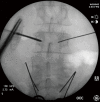The use of minimally invasive surgery in spine trauma: a review of concepts
- PMID: 31380497
- PMCID: PMC6626750
- DOI: 10.21037/jss.2019.04.13
The use of minimally invasive surgery in spine trauma: a review of concepts
Abstract
Traumatic injuries to the spine can be common in the setting of blunt trauma and delayed diagnosis can have a deleterious effect on patients' health. The goals of treatment in managing spine trauma are prevention of neurological injury, providing stability to the spine, and correcting post-traumatic deformity. Minimally invasive spine surgery (MISS) techniques are an alternative to open spine surgery for treatment of spine fractures. MISS is also a viable treatment in the setting of damage control orthopedics, when patients with multiple traumatic injuries may be unable to tolerate a traditional open approach. MISS techniques have been used in the treatment of unstable fractures with or without spinal cord injury, flexion and extension-distraction injuries, and unstable sacral fractures. Traditional open surgeries have been associated with increased blood loss, longer operative times, and a higher risk for surgical site infection (SSI). MISS techniques have the potential to reduce open approach-associated morbidity, and improve postoperative care and rehabilitation. MISS techniques for spine trauma are an indispensable option in the treatment armamentarium of spine surgeons.
Keywords: Spine trauma; damage control orthopedics; minimally invasive spine surgery (MISS); spine fractures; thoracolumbar (TL) spine.
Conflict of interest statement
Conflicts of Interest: SC Ludwig: American Board of Orthopaedic Surgery, Inc., Board or committee member; American Orthopaedic Association, Board or committee member; AO Spine North America Spine Fellowship Support, Research support; ASIP, ISD, Stock or stock Options; Cervical Spine Research Society, Board or committee member; DePuy, A Johnson & Johnson Company, IP royalties, Paid consultant, Paid presenter or speaker; Globus Medical: Paid consultant, Research support; Journal of spinal disorders and techniques, Editorial or governing board; K2M spine, Research support; K2Medical, Paid consultant; OMEGA, Research support; PACIRA, Research support; SMISS, Board or committee member; Synthes, Paid consultant, Paid presenter or speaker; Thieme, QMP, Publishing royalties, financial or material support. The other authors have no conflicts of interest to declare.
Figures



References
Publication types
LinkOut - more resources
Full Text Sources
